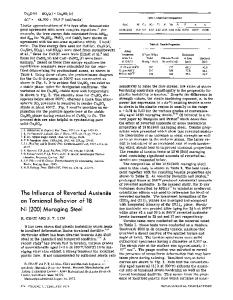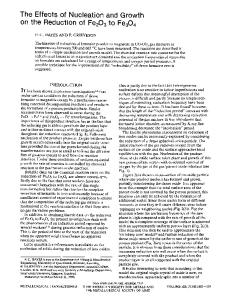Thermodynamic study of Fe 2 O 3 -Fe 2 (SO 4 ) 3 equilibrium using an oxyanionic electrolyte (Na 2 SO 4 - I )
- PDF / 636,490 Bytes
- 7 Pages / 603.28 x 783.28 pts Page_size
- 93 Downloads / 355 Views
I.
INTRODUCTION
CHEMICAL potential diagrams depicting equilibria in MS-O systems' constitute the basis for understanding the physical chemistry of roasting processes. These diagrams provide useful guidelines to optimize the roasting conditions and to produce products of desired chemistry. Accurate information on the free energies of formation of oxides, sulfides, and sulfates are essential for construction of stability field diagrams. The bivariant phase equilibria in metalsulfur-oxygen (M-S-O) systems have been traditionally investigated using the gas equilibrium methods, in combination with thermogravimetric or differential thermal analysis2'3'4 to detect the onset of reaction, and high temperature galvanic cells with oxide solid electrolytes. 5'6'7 Thermodynamics of bivariant oxide-sulfate equilibria in systems of chemical metallurgical interest have been critically reviewed by Kellogg. 8 Formation and stability of oxides and sulfates are exploited in the separation of metals by selective sulfation. For example, low stabilities of sulfates of iron permit selective sulfation of copper in the presence of iron. 9 Important oxide-sulfate bivariant equilibria in the Fe-S-O system between 700 and 1100 K are: (Fe203} + 3(SO2) + -~(O2) --+ (Fez(SO4)x}
[11
(Fe20,) + 2(S02) + 2(02) ---+ 2{FeS04}
[21
2(FeSO4) + (SO2) + (02) ---+ 2(Fe2(504)3)
[3]
(Fe304} + 3(SO2) + (02)--+ 3(FeSO,}
[4]
A
where symbols ( ) and ( ) denote solid and gas phase, respectively. The standard free energy change for reaction [ 1] has been measured by TGA and DTA techniques 2'3 and by solid oxide galvanic cells. 5"7Skeaff and Espelund5 have also measured data for reactions [2] and [3]. Formation of oxyK. T. JACOB, Professor, and G. N. K. IYENGAR, Associate Professor, are with the Department of Metallurgy, Indian Institute of Science, Bangalore 560 012, India. Manuscript submitted October 15, 1985.
METALLURGICALTRANSACTIONSB
sulfate suggested by Alcock et al. 2 has not been confirmed by other investigators. Jacob and Rao 1~have shown that Na2SO44 is a sodium ion conductor and can be used as the solid electrolyte in a galvanic cell for the measurement of SO3/SO2 partial pressures. The present study attempts to demonstrate the use of Na2SO4-I for the thermodynamic study of sulfates. Ferric sulfate was chosen because of its industrial importance and significant discrepancies in its Gibbs' energy data. 3"~'7Recently Gauthier and Bale" have used solid K2SO4 as a solid electrolyte for the study of oxide-sulfate equilibrium in systems containing Mg, Ni, and Mn.
II.
EXPERIMENTAL
A. Materials
Powdered, anhydrous, 99.99 pct pure Na2SO4 was used as the starting material. Pellets of 1.6 cm diameter and 0.4 cm thick, made by double end compression of the fine powder, were sintered at 1090 K for 87 ks. Pellets prepared by this method had 98 pct of the theoretical density. Anhydrous ferric sulfate was prepared by drying the hydrated analytical grade ferric sulfate at 393 K in air for 180 ks followed by heating at 1073 K in SO2 for about 65 ks. A refe
Data Loading...











